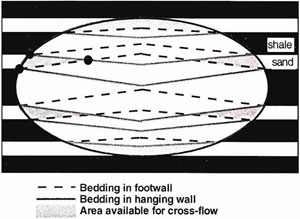| |||||||
|
|
|||||||
|
|
|||||||
| Porosity and Permeability affected by Juxtaposition | |||||||
|
Juxtaposition of different units is a natural consequence of faulting. If the displaced units are of different hydraulic properties, which they almost always are, juxtaposition should be taken into account. Juxtaposition may have a significant impact on fault normal permeability. However, it won't have much influence on permeability of faults along the fault. When no information about the actual fault zone is available, juxtaposition provides some estimate on the permeability changes that are imposed by a fault. In such estimation, a fault is treated as an ideal plane, ignoring the structure of the fault zone. For example, in a sequence of shale-sand layers, an ideal elliptical fault plane with linear slip variation would define a juxtaposition pattern shown in Figure 1. Layers that occur at the fault's center have large surface area, but only a small part is available for cross flow. Layers at the top and bottom of the fault, in contrast, have small surface area, though nearly completely available for cross flow (Willemse, 1996). When a permeable rock layer is juxtaposed upon a less permeable one across a fault, the fault effectively acts as a seal and reduces the fault normal permeability of the permeable layer. This is called juxtaposition seal. Allan (1989) provides a method for constructing juxtaposition diagrams. For various examples of this method and its use in fault seal analyses, see Knipe et al. (1998), Knai and Knipe (1998), Koledoye et al. (2003), and Childs et al. (2000). | |||||||
| Reference: |
|||||||
| Allan, U.S., 1989 Childs, C., Sylta, O., Moriya, S., Walsh, J.J., Manzocchi, T., 2002 Knai, Knipe, R.J., 1998 Koledoye, B., Aydin, A., May, E., 2003 Willemse, E.J.M, 1996 |
|||||||
|
Readme | About Us | Acknowledgement | How to Cite | Terms of Use | Ⓒ Rock Fracture Knowledgebase |
|||||||
